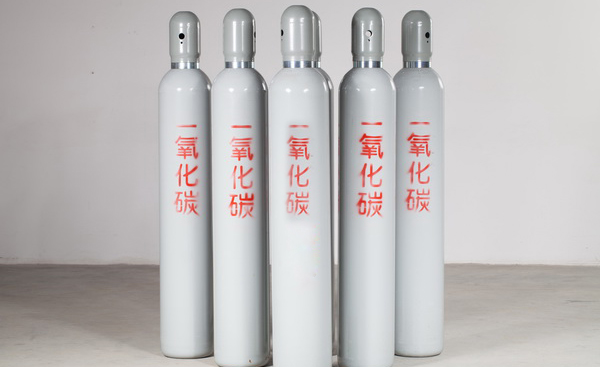Carbon Monoxide
Release Date: 2022-06-16 10:49:27 Visit: 234

Carbon monoxide is a colorless, odorless, tasteless, non-irritating asphyxiating gas at normal temperature and pressure. The gas density of carbon monoxide is 1.25g/L under standard conditions, which is close to the density of air (1.293g/L under standard conditions). In the industry, gray steel cylinders are commonly used in packaging, and the words "carbon monoxide" are sprayed in red on the cylinders, and flammable, compressed, and toxic signs are attached. The valve uses a bottle head valve with a reverse thread outlet such as QF-30C. Carbon monoxide is flammable in air and emits a blue flame when burning. The explosion limit in air is 12.5% to 74%.
Carbon monoxide poisoning is that its affinity with hemoglobin is 300 times higher than that of oxygen and hemoglobin. Therefore, carbon monoxide can easily combine with hemoglobin, so that hemoglobin loses its oxygen-carrying ability and function, resulting in hypoxia and suffocation of brain and other tissues. Save yourself. Gas poisoning is usually called carbon monoxide poisoning.
The production of industrial carbon monoxide includes methanol cracking to carbon monoxide, water gas to carbon monoxide, etc., using yellow phosphorus tail gas, closed calcium carbide furnace gas, steelmaking converter gas, blast furnace gas, carbon black tail gas and other industrial exhaust gas rich in carbon monoxide to purify and recover carbon monoxide. It is an environmentally friendly and efficient production method.
At high temperature and pressure, carbon monoxide reacts with metals such as iron, chromium, and nickel to form metal carbonyls, which combine with chlorine to form phosgene, and combine with metal carbonyls to form metal carbonyl compounds. Carbon monoxide has a reducing effect. When manganese and copper oxides are mixed at room temperature, carbon monoxide can be oxidized to CO2. There is a gas mask that uses this principle. Carbon monoxide is mainly used as fuel, reducing agent, raw material for organic synthesis, for the preparation of metal carbonyls, phosgene, carbon sulfide, aromatic aldehydes, formic acid, benzene hexanol, aluminum chloride, methanol, for hydroformylation, For tilapia preservation, preparation of combined hydrocarbon (synthetic gasoline), combined alcohol (mixture of carboxyl, ethanol, aldehyde, ketone and hydrocarbon), zinc white pigment, aluminum oxide film formation, standard gas, calibration gas, online instrumentation Standard gas.
Application of carbon monoxide
Bottled carbon monoxide is often used for the preservation of tilapia and is an excellent gas coloring agent for aquatic products.
Factory exhaust gas rich in carbon monoxide is used to synthesize methanol, etc., supporting the creation of profits in the spirit of environmental protection.
Carbon monoxide is used to prepare carbon monoxide standard gas to calibrate carbon monoxide alarms.
High-purity carbon monoxide is used to synthesize fine chemicals such as medicines, pesticides, fragrances and important intermediates.
Carbon monoxide is used as a reducing gas for metal reduction in order to purify certain metals.
Gas as fuel cell.
Carbon monoxide is used in medical research and can aid in organ transplants.
Carbon monoxide precautions
Bottled carbon monoxide is a high-pressure filling gas. It should be decompressed and depressurized before use. Before use, the gas pipeline must be pressure tested with nitrogen, leak tested with soapy water, and leak tested with helium to ensure that the gas pipeline does not leak. The working environment should be ventilated and carbon monoxide alarms should be installed. The alarm should be periodically calibrated with carbon monoxide standard gas.
When moving and transporting carbon monoxide cylinders, you should wear the cylinder cap, use a trolley specially designed for cylinders, and fix the cylinders with iron chains to ensure that the valve components of the cylinders are not damaged. For long-distance transportation, professional gas dealers such as Spectrum Gas should be hired to transport them with dangerous goods transportation vehicles.
The carbon monoxide gas cylinders in the package have the service life. Any expired gas cylinders must be sent to the relevant department for safety inspection by the corresponding dealer before they can continue to be used.
When the exhaust gas of each bottle of gas is used, the residual pressure in the bottle should be kept at 0.5MPa, and the minimum residual pressure should not be lower than 0.25MPa. The bottle valve should be closed to ensure gas quality and safe use.
Bottled carbon monoxide should be classified and stacked during transportation, storage and use. It is strictly forbidden to stack combustible gas and combustion-supporting gas together. It is not allowed to be close to open flames and heat sources. Do not strike, it is strictly forbidden to start arc or electric arc on the carbon monoxide cylinder, and it is strictly forbidden to load and unload it brutally.





